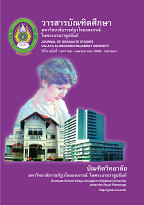การวิเคราะห์องค์ประกอบของรูปแบบกลยุทธ์การตลาดบริการสายการบินราคาประหยัดในมุมมองของผู้ใช้บริการรองรับสู่ประชาคมเศรษฐกิจอาเซียน
Main Article Content
Abstract
บทคัดย่อ
การวิจัยเรื่องนี้มีวัตถุประสงค์การวิจัยเพื่อ 1) ศึกษาสถานการณ์ปัจจุบัน ปัญหา อุปสรรค์ของการตลาดบริการสายการบินราคาประหยัด 2) การวิเคราะห์กลุ่มองค์ประกอบเชิงสำรวจของรูปแบบกลยุทธ์การตลาดบริการสายการบินราคาประหยัดให้รองรับสู่ประชาคมเศรษฐกิจอาเซียนในมุมมองผู้ใช้บริการ 3) เพื่อยืนยันความเหมาะสมขององค์ประกอบที่พัฒนาขึ้นสำหรับรูปแบบกลยุทธ์การตลาดบริการสายการบินราคาประหยัดให้รองรับสู่ประชาคมเศรษฐกิจอาเซียนในมุมมองผู้ใช้บริการ โดยการดำเนินการวิจัยเป็นแบบผสมผสาน การวิจัยเชิงคุณภาพใช้การสัมภาษณ์เชิงลึก กับกลุ่มตัวอย่างแบบ
สโนว์บอลต่อผู้มีส่วนได้เสีย ประกอบด้วยผู้เชี่ยวชาญ ผู้บริหารของทั้งภาครัฐ และเอกชนที่เกี่ยวข้องกับสายการบินราคาประหยัดที่จดทะเบียนในประเทศไทยรวมถึงผู้ใช้บริการสายการบิน โดยปรับใช้แนวคิด 7S ของแม็คคินซี่ เป็นแบบสัมภาษณ์เพื่อหาปัจจัยในการนำสู่กระบวนการวิจัยเชิงปริมาณโดยใช้โปรแกรมสำเร็จรูปทางสถิติขั้นพื้นฐานในการวิเคราะห์ การแจกแจงความถี่ ค่าร้อยละ ค่าเฉลี่ย และค่าเบี่ยงเบนมาตรฐาน และใช้โปรแกรมสำเร็จรูปทางสถิติขั้นสูงวิเคราะห์องค์ประกอบแบบเชิงสำรวจ และเทคนิคการวิเคราะห์องค์ประกอบเชิงยืนยันตามทฤษฎีการตลาดบริการผสมผสาน กับกลุ่มตัวอย่างที่ใช้บริการสายการบินราคาประหยัดที่จดทะเบียนในประเทศไทย จำนวน 781 รายจาก 7 สายการบิน
ผลการวิจัยพบว่า 1) กลยุทธ์ของสายการบินราคาประหยัดกำหนดต้นแบบการบริหารงาน และมอบอำนาจให้ภารกิจสำเร็จตามวัตถุประสงค์ เต็มความสามารถตามสภาพแวดล้อมพื้นที่ โดยมุ่งเน้นการติดต่อสื่อสารที่ถูกต้อง กระชับ 2) โครงสร้างของสายการบินราคาประหยัด มีต้นแบบโครงสร้างการบริหาร อำนาจการสั่งการ โดยอำนาจดังกล่าวมีเบ็ดเสร็จตามพื้นที่บริการ 3) ระบบของสายการบินราคาประหยัด นำต้นแบบการบริหารมาประยุกต์ใช้ โดยกำหนดหลักเกณฑ์การดำเนินการอย่างเป็นอิสระตามสภาพแวดล้อมของสังคมในพื้นที่บริการ 4) ค่านิยมของสายการบินราคาประหยัดมีเอกลักษณ์วัฒนธรรมองค์กร ร่วมใจสนับสนุนการทำงานทุกพื้นที่อย่างเต็มใจ เต็มความสามารถ และตระหนักถึงความเสี่ยงทุกประเภท 5) สไตล์ของสายการบินราคาประหยัด มีการกระจายความรับผิดชอบ ปรับลดระเบียบปฏิบัติภายใน ตามลักษณะพื้นที่บริการโดยมุ่งเน้นการประสานงานอย่างใกล้ชิด 6) บุคลากรของสายการบินราคาประหยัด มีทัศนคติเป็นหนึ่งเดียวกับหน่วยงาน แม้แตกต่างทั้งด้านพื้นที่งาน สภาพแวดล้อม และสังคม 7) ทักษะของสายการบินราคาประหยัด มีทักษะพื้นฐานทางบริการ การประสานงานที่ยอดเยี่ยม มีการอบรมพัฒนาบุคคลากรอย่างเป็นระบบ
2) พบว่าองค์ประกอบเชิงสำรวจ สามารถจัดองค์ประกอบได้ทั้งหมด 5 องค์ประกอบร่วมซึ่งสามารถอธิบายความแปรปรวนของตัวแปรที่ใช้วัดกลยุทธ์การตลาดบริการสายการบินราคาประหยัดรองรับสู่ประชาคมเศรษฐกิจอาเซียนได้ร้อยละ 66.993 โดยองค์ประกอบที่ 1 กลยุทธ์ด้านพนักงานและกระบวนการบริการ องค์ประกอบที่ 2 กลยุทธ์ด้านการจัดการสิ่งแวดล้อมและลูกค้าสัมพันธ์ องค์ประกอบที่ 3 กลยุทธ์ด้านภาพลักษณ์การบริการและราคาที่กำหนด องค์ประกอบที่ 4 กลยุทธ์ด้านการสื่อสารการตลาดเพื่อจำหน่าย และ องค์ประกอบที่ 5 กลยุทธ์ด้านเบ็ดเตล็ดทั้ง 5 องค์ประกอบอธิบายความแปรปรวนได้ร้อยละ 19.425, 13.897, 12.461, 12.363, 8.848 ตามลำดับ
3) พบว่ารูปแบบกลยุทธ์การตลาดบริการสายการบินราคาประหยัดให้รองรับสู่ประชาคมเศรษฐกิจอาเซียนในมุมมองผู้ใช้บริการ นำเสนอการพัฒนาเพื่อยืนยันองค์ประกอบที่เหมาะสม มีดัชนีทุกองค์ประกอบได้แก่ 2/df = 2.908, GFI = 0.915, AGFI = 0.903, CFI = 0.908, TLI = 0.917, PGFI = 0.696, RMSEA = 0.043 และ RMR = 0.039 ที่พัฒนาขึ้น มีความกลมกลืนกับข้อมูลเชิงประจักษ์ โดยมีลักษณะดังรูปที่พัฒนาขึ้นประกอบด้วย 5 องค์ประกอบได้แก่ กลยุทธ์ด้านการจัดการสิ่งแวดล้อมและลูกค้าสัมพันธ์ กลยุทธ์ด้านพนักงานและกระบวนการบริการ กลยุทธ์ด้านการสื่อสารการตลาดเพื่อจำหน่าย กลยุทธ์ด้านภาพลักษณ์การบริการและราคาที่กำหนด กลยุทธ์ด้านเบ็ดเตล็ด มีค่าน้ำหนักองค์ประกอบ 0.935, 0.901, 0.865, 0.838, 0.836 ตามลำดับ
ABSTRACT
This objective’s research were 1) study current situations, problems, obstructing of marketing strategy model of budget airlines for AEC according to passengers' viewpoint; 2) analyzed and organized into groups of factors of service marketing strategy model of budget airlines for AEC according to passengers' viewpoint; 3) confirmed the appropriateness of developed factors of service marketing strategy model of budget airlines for AEC according to passengers' viewpoint. The mixed methods were proposed.
The Depth Interview of quality research used for steak holders (Aviation sectors: Expert, Executives both government and private sector, passengers) by Snowball Sampling Technique. The 7S of McKinsey’s framework was adapted used to the interview questions to conclude factors which leaded to the process of quantity research. The instant descriptive statistic program was used for Frequency Distribution, Percentage, Mean, and Standard Deviation. The instant high statistic program was used for Exploratory Factor Analysis (EFA) and Confirmatory Factor Analysis (CFA). The 781 passengers in 7 Thai registered budget airlines were sample group.
The result of the first research objective found that 1) Strategy of Budget Airlines was granted parenting styles on missions through communication; 2) Structure of Budget Airlines was management structure combined with power structure and local empowerment; 3) System of Budget Airlines was utilized approval system through procedure rules on local autonomy; 4) Shared Values of Budget Airlines was organization identity, culture of willing to process, fully co-operation and encourage to all different locations, and attitude to all risks; 5) Style of Budget Airlines was devolution, Intrapreneurship, attitude to top management, co-operation; 6) Staff of Budget Airlines had attitude involved organization’s identity, engage and spread of abilities to social; 7) Skill of Budget Airlines was obtaining core competency and willing to develop systematically. The second research objective found that EFA indicated 5 jointed factors, interpreted 66.993% of variance calculating service marketing strategy of budget airlines for AEC according to passengers' viewpoint: Factor 1) Strategy of Staff and Service Process; Factor 2) Strategy of Physical Evidence Management and Customer Relation Management; Factor 3) Strategy of Service Image and Price Providing; Factor 4) Strategy of Market Communication for Sale; Factor 5) Strategy of Piecemeal. All 5 factors indicated the variance as: 19.425, 13.897, 12.461, 12.363, 8.848 respectively. The third research objective found that the service marketing strategy model of budget airlines for AEC according to passengers' viewpoint was fitted to data and shown the developed model to confirm appropriated factors with necessary Indexes: 2/df = 2.908, GFI = 0.915, AGFI = 0.903, CFI = 0.908, TLI = 0.917, PGFI = 0.696, RMSEA = 0.043 and RMR = 0.039, concordant with empirical data. The developed model consisted of five strategically factors: strategy on Physical Evidence Management and Customer Relation Management; strategy on People and Service Processing; strategy on Marketing Promotion/Integrated Marketing Communication and Place; strategy on Service Image and Price Set; strategy on Others in Composed. Those weight factors were 0.935, 0.901, 0.865, 0.838, 0.836 respectively.
Article Details

This work is licensed under a Creative Commons Attribution-NonCommercial-NoDerivatives 4.0 International License.
บทความทุกเรื่องได้รับการตรวจความถูกต้องทางวิชาการโดยผู้ทรงคุณวุฒิ ทรรศนะและข้อคิดเห็นในบทความ Journal of Global of Perspectives in Humanities and Social Sciences (J-GPHSS) มิใช่เป็นทรรศนะและความคิดของผู้จัดทำจึงมิใช่ความรับผิดชอบของบัณฑิตวิทยาลัย มหาวิทยาลัยราชภัฏวไลยอลงกรณ์ ในพระบรมราชูปถัมภ์ กองบรรณาธิการไม่สงวนสิทธิ์การคัดลอก แต่ให้อ้างอิงแหล่งที่มา


